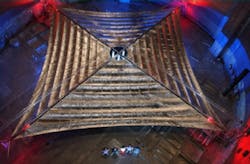NASA's choices for flight-demo projects include optical communications, solar sail
Washington, DC--Three space-technology demonstration proposals chosen by NASA include a laser communications system, a solar sail, and a deep-space atomic clock. The clock and solar sail will be ready for flight in three years, while the optical communications team anticipates that it will take four years for the laser system to be ready for flight. To reduce cost, the technology demonstrations will ride to space with other payloads aboard commercially provided launch vehicles. Launches are anticipated in 2015 and 2016.
The proposals are:
- Laser Communications Relay Demonstration; David Israel, principal investigator at NASA's Goddard Space Flight Center (Greenbelt, MD). Optical communications technology provides data rates up to 100 times higher than today’s systems. The technology is applicable to the next generation of NASA's space-communications network.
- Beyond the Plum Brook Chamber, An In-Space Demonstration of a Mission-Capable Solar Sail; Nathan Barnes, principal investigator at L'Garde Inc. (Tustin, CA). The Solar Sail demonstration mission will deploy and operate a sail area seven times larger than ever flown in space; the sail is pushed by the force of light. It is potentially applicable to a wide range of future space missions, including an advanced space weather warning system to provide more timely and accurate notice of solar-flare activity. This technology also could be applied to economical orbital debris removal and propellantless deep-space exploration missions. The National Oceanic and Atmospheric Administration is collaborating with NASA and L'Garde Inc. on the demonstration.
- Deep Space Atomic Clock; Todd Ely, principal investigator at the California Institute of Technology/NASA's Jet Propulsion Laboratory (Pasadena, CA). The Deep Space Atomic Clock demonstration mission will fly and validate a miniaturized mercury-ion atomic clock that is ten times more accurate than today’s systems. This project will demonstrate ultraprecision timing in space and its benefits for one-way radio navigation. The investigation will fly as a hosted payload on an Iridium spacecraft and make use of GPS signals to demonstrate precision orbit determination and confirm the clock's performance. Precision timing and navigation is critical to the performance of a wide range of deep-space exploration missions.
"Optical communication will enable rapid return of the voluminous data associated with sending spacecraft and humans to new frontiers," said NASA Chief Technologist Bobby Braun. "High-performance atomic clocks enable a level of spacecraft navigation precision and autonomous operations in deep space never before achieved, and solar sails enable new space missions through highly efficient station-keeping or propellantless main propulsion capabilities for spacecraft."
NASA's Office of the Chief Technologist plans to make a total investment in these three missions of approximately $175 million, contingent on future appropriations. Each of the selected teams also will receive funding from partners who plan on using the technologies as part of future space missions. Projects include all elements of the flight-test demonstration, including test planning, flight hardware, launch, ground operations, and post-testing assessment and reporting.
About the Author
John Wallace
Senior Technical Editor (1998-2022)
John Wallace was with Laser Focus World for nearly 25 years, retiring in late June 2022. He obtained a bachelor's degree in mechanical engineering and physics at Rutgers University and a master's in optical engineering at the University of Rochester. Before becoming an editor, John worked as an engineer at RCA, Exxon, Eastman Kodak, and GCA Corporation.

